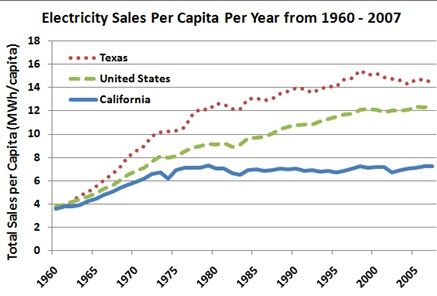CA’s legendary energy efficiency is statistical myth
By now many of you have seen the legendary chart nearby. It shows that California energy use per person has remained relatively flat, while the trend for the other states has risen significantly during the last 50 years. It has been widely touted by the State of California and environmental organizations that this trend is due to the state’s energy efficiency regulations for homes, cars and industries.
This leveling off of California electricity usage since the 1970s compared to other states has received so much unquestioned academic acceptance that it was given the term “The Rosenfeld Effect” after U.C. Berkeley physicist Arthur Rosenfeld, who championed the energy conservation movement in the 1970s. Rosenfield boasts that the iconic chart of vastly lower energy usage by California is a “Graph Worth a Thousand Gigawatt Hours.” The chart has also become a media myth.
But is it true?
A new study conducted by the prestigious non-partisan National Bureau of Economic Research, “California Energy Efficiency: Lessons for the Rest of the World, or Not?,” casts serious doubt on the claim of California’s legendary energy efficiency compared to other states. No less than economist Arik Levinson, who was appointed by President Obama to the White House Council of Economic Advisors, conducted the study.
Levinson said, “95 percent of California’s apparent electricity savings can be explained by coincidental trends” having nothing to do with regulated energy usage of homes, cars or industrial plants.
No. 1 Energy efficiency factor: Household size
According to Levinson, the biggest factor in California’s lesser usage of electricity is nothing but larger household size. Here’s the way Levinson describes it:
“While electricity use increases with the number of people per home, it does so at a decreasing rate. As a consequence, electricity use per household member, or per capita, declines with household size.”
The more people who live in a particular home, the more people use the same appliances and heating and cooling systems. Thus, relying on energy use data per person can be misleading.
Determinants of California’s Energy Efficiency
| Demographic changes including average household size | 61% |
| Nationwide income growth higher than California | 20% |
| U.S. population shift to Southwest | 15% |
| Total coincidental trends having nothing to do with energy efficiency regulations | 96% |
| Possible energy savings due to regulations | 4% |
| Source: National Bureau of Economic Research | |
No. 2 Energy Efficiency Factor: Less Income Growth
The second largest factor in explaining the mirage of California’s superior energy conservation is that income growth in other states was larger than in California. The greater the household income, the more that air conditioners will be used on hot days and heaters on cold days.
The incomes of California households grew by 26 percent less that it did in other states, on average. Relatively greater rising affluence in states like Texas resulted in higher use of electricity compared to California.
Thus the graph showing Texas consuming more electricity per person than California is misleading. What that graph really shows is Californians are less able to pay for electricity than Texas and other states. Relative income growth accounted for 20 percent of California’s energy savings, according to Levinson.
No. 3 Energy Efficiency Factor: Shift to Southwest U.S.
The third greatest factor in why California’s electricity usage has flat lined is the shift of the U.S. population to the Southwest, especially after the decline of the Rust Belt in the 1980s. The Southwest has larger and newer homes and a hotter climate, thus causing higher costs to cool homes. When a family moves from Detroit to Phoenix, it uses more energy.
The population shift to the Southwestern United States resulted in the average of other states using more electricity per person compared to California. This accounted for 15 percent of California’s reduced electricity consumption in Levinson’s study.
Older homes use less electricity
Another astounding finding of the study is, “Older homes use less electricity.” Older homes are built to breathe and their windows let heated or cooled air escape.
But modern energy-tight buildings in California, mandated under Title 24 Building Energy Efficiency Regulations, do not allow heat or cold to escape through windows, attics or vents. Supposedly energy-tight buildings waste less energy.
Nonetheless, the data show those households living in older homes have a lower level of electricity usage. So much for costly housing energy retrofit programs.
Declining energy use a mirror of CA’s economic decline
Electricity usage has not only been falling in the residential sector, but in every sector, according to Levinson.
Levinson describes declining residential electricity usage as the “poster child” of California energy efficiency regulations. But residential structures only used 4 percent of California’s electricity in 2009. And 95 percent of that usage was attributed to purely unregulated reasons such as California’s more moderate climate, larger average household size, relatively less household income growth than other states, and the shift of households outside California into larger homes.
As for declining industrial electricity usage, Levinson points out that California may simply be losing manufacturing at a faster rate than other states. Another possible explanation is that it might be that California’s regulations are actually suppressing electricity usage.
What Levinson actually found, however, is that California’s industrial electricity demand grew as much or more than the nation on average. But California industrial energy usage has merely grown less quickly than in other states. Usage thus was unable to keep up with demand.
Even California’s much touted claim of energy savings in cars and trucks is entirely explained by other states’ driving more, not by California vehicles being more energy efficient.
Levinson concludes that the data undermine support for California energy efficiency standards as the cause of the state’s relatively lower energy usage. The data indicate California’s energy efficiency standards have not been effective, should not be tightened or adopted elsewhere, and cannot reduce “global warming or climate change.”
California Energy Policies
| Warren Alquist Act | Established the California Energy Commission (CEC) with authority to regulate appliances and later buildings | 1974 |
| Title 20 | First appliance standards | 1976 |
| Title 24 | First building standards in the U.S. | 1978 |
| Decoupling natural gas profits from sales | 1978 | |
| Decoupling electric utility profits from sales | 1978 | |
| AB 1890 | Restructuring of electricity industry, mandated investment in public benefit programs | 1996 |
| AB 32 | Global Warming Solutions Act | 2006 |
| Source: National Bureau of Economic Research | ||
Related Articles
Sacto's grimy light rail system
Steven Greenhut: I had to leave a car in the shop this week, so I got initiated into Sacramento’s light-rail
Star-Studded Cal State fundraising galas net little profit
July 17, 2012 By John Hrabe When Grammy-award winning funk legends Earth, Wind and Fire performed at Cal State Fullerton’s
Can CA public-employee pensions be reformed?
Almost everyone acknowledges that California’s public pension system needs reform. Gov. Jerry Brown brought up reform in his his Jan.




